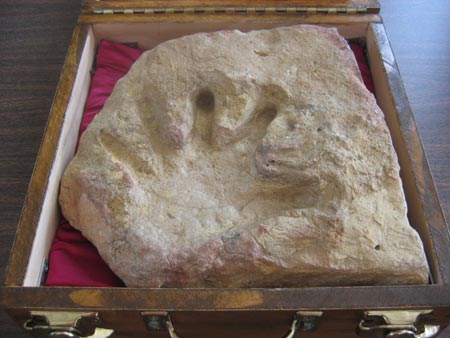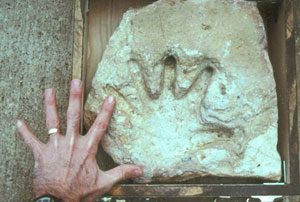

|
| Alleged Human Hand Print. (C) 2006 Glen Kuban |
Part of Kuban's Paluxy web site
An impression on a loose block of rock has been promoted as a human "hand print" by Carl Baugh and a handful of other strict creationists. The supposed print is described as follows in the "museum displays" section of Baugh's Creation Evidence Museum (CEM) web site :

|
| Alleged Human Hand Print. Photo at CEM website |
"This photo shows a human handprint found in Cretaceous rock in the same layer with the Glen Rose dinosaur footprints. The fossil handprint is so specific that it displays impressions of the thumbnail, impressions of the tissue webbing between the thumb and index finger, and the impression left by penetration of the middle finger into the mud." (Baugh, 2006)
Despite Baugh's assertions, he provides no photos or other evidence indicating that the impression was ever in situ in any Cretaceous bed. If it were a real hand print, one would expect it to be associated with a sequence of footprints. Without such evidence, the alleged hand print is of little or no scientific value.
A 2006 website by "Pastor Art and Sister Sue" from Houston Texas state that the "hand print on stone" was discovered "in 1995 in Cretaceous rock near Weatherford, Texas." but do not cite the source of this information. Nor do they indicate who found it, or whether it was documented in situ. The authors state, "Spiral cat scan showed depression down and forward." but no images of the reported scan are shown.
In June 2006 I examined the loose slab in person at Baugh's little museum in Glen Rose, Texas. I was only allowed to examine the block for a limited period of time, and without further documentation, it may be impossible to determine whether the rock is ancient or relatively recent, and whether the marking is a natural print, enhanced from a less distinct non-human impression or print, or entirely carved. My initial impression was that parts of it (mostly on the right side) looked more natural than others. This left me suspecting that it may well have been a nonhuman impression that resembled part of a human hand print, which was then enhanced and extended by carving.
It should be noted that Baugh has promoted a number of other alleged prints on loose rock slabs, such as the Burdick Track and the Caldwell track, which even most creationists consider carvings or probably carvings. Cross sections of the "hand print" might help clarify its origin, but so far it has not been sectioned.
This loose "hand print" should not be confused with another alleged "hand print" that Baugh promoted during his first Glen Rose excavation in 1982 behind the McFall property (at what some now call the "Baughanthropus site").* Although initially touted by Baugh as a definite hand print, the marking was a shallow and ambiguous feature on a coarse and friable surface, and attracted little attention even among Baugh's followers. Evidently Baugh himself no longer promotes it (at least it is not featured on his web site or mentioned in his recent literature).
Finally it should be emphasized that when an extraordinary claim is made, the burden is on the claimants to demonstrate their case, not on others to prove them wrong. As usual, Baugh's claims about this human "hand print" in Cretaceous rock far exceed the evidence provided.
* It is called this because at the site Baugh posted a metal sign stating that a trail of alleged human tracks overlapping dinosaur tracks there were made by Humanus baughanthropus. No explanation was given for why the "man tracks" would be of a different species than Homo sapiens let alone a different genus if the trackmaker were human. The "human" tracks there were actually dinosaur metatarsal impressions; left by dinosaurs that (in this case) impressed portions of their soles and heels as they walked.